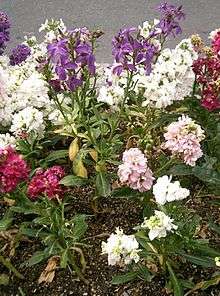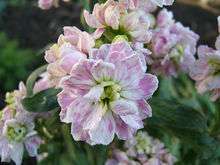Matthiola incana
Matthiola incana, known as hoary stock,[1] is a species of flowering plant in the genus Matthiola. The common name stock usually refers to this species, though it may also be applied to the whole genus. The common name "night-scented stock" or "evening-scented stock" is applied to Matthiola longipetala (syn. bicornis).[2] M. incana is also known in the USA by the common name tenweeks stock.[3] It is a common garden flower, available in a variety of colours, many of which are heavily scented and also used in floristry.
| Matthiola incana | |
|---|---|
 | |
| Scientific classification | |
| Kingdom: | Plantae |
| Clade: | Tracheophytes |
| Clade: | Angiosperms |
| Clade: | Eudicots |
| Clade: | Rosids |
| Order: | Brassicales |
| Family: | Brassicaceae |
| Genus: | Matthiola |
| Species: | M. incana |
| Binomial name | |
| Matthiola incana | |
Description
Some stocks are grown as annuals (the "ten-week stocks") that reach heights of growth of 20 to 28 centimeters thick, woody at the base and with numerous foliar scars and branches with terminal rosettes of leaves. The plants are starry, with whitish hairs. The leaves are rounded and ash-coloured. The fragrant flowers are white, cream yellow, pink, red, purple or blue. The scar flaps on the back are swollen. The pods are compressed, their flaps are flattened. Leaves whole or slightly sinuate, lanceolate, attenuated on a short petiole. Pedicels are 10-12 mm in anthesis, 12-17 mm in fruiting, erect-patents. Sepals are around 11-14 mm, with narrow scarious margin, subtle, green or somewhat purple. Petals are 25-30 mm, with a nail almost as long as the limb, ranging between white, pink, violet or purple. Seeds are 2-3 mm, suborbicular, with a whitish wing. The flower is supported by a 10-20 mm stalk.[4]
Distribution
It is native to southern Europe (from the Balearics to the former Yugoslavia) and is naturalized in the western part of the Mediterranean region, roughly in the areal of the olive tree. The plant prefers calcareous soils, and often grows on cliffs overlooking the sea, or on old walls. It is a plant of the coast, but it can be found, naturalized, even in the hinterland up to 600 m of altitude.[5]
Usage

The flower is widely used as an ornamental plant for summer discounts and as a cut flower and aromatic plant. It is grown in the ground for the spring ornament of the gardens or in pots. It is very suitable for the cracks in the reefs of the marine locations. The species has been in culture since at least the 16th century. The flowers can be simple or filled, medium or large.[6]
Varieties
These varieties are sown in spring (generally from March onwards in colder areas of the Northern Hemisphere, earlier in regions with mild winters). They give a good summer flower display. Other varieties take longer to develop and are treated as biennials. These are often referred to as "Brompton stocks". In cool temperate regions they are generally sown in summer (June and July) to flower in the following spring. The extra trouble of overwintering the plants is compensated for by the showy spring floral display. In hard winters there may be some mortality and a well-drained sheltered site suits them best.[7]
Intermediate varieties (sometimes called "East Lothian" stocks as they originated in southern Scotland) may be treated either as annuals or biennials. If treated as annuals they give a fine late summer and autumn display. Maltese stocks (Matthiola incana ssp. melitensis), known in Maltese as "ġiżi ta' Malta", is treated as a perennial and has fleshier and fuzzy leaves with flowers in a light violet colour, while an even rarer variety of it exhibits white flowers.[8] 'Cinderella series' has gained the Royal Horticultural Society's Award of Garden Merit. [9][10]
Genetics
Double-flowered stocks are prized by gardeners for their floral display but are sterile. They therefore have to be produced from the seed of single-flowered plants. The double-flowered form is caused by a recessive gene variant (allele) in the homozygous condition. Therefore, according to the Mendelian laws of genetics, heterozygous single-flowered stocks should produce one quarter doubles in their offspring and one third of the singles should be pure breeding singles incapable of throwing doubles.
Selection over the centuries has greatly improved these ratios, resulting in the so-called "ever-sporting" stocks, in which pure-breeding singles are absent and the proportion of doubles is one half or greater. The reason was first worked out by the Danish geneticist Øjvind Winge.[11] In these varieties, the singleness allele is closely linked to a pollen-lethal gene. Thus the pollen (male) contribution to seed is always a doubleness allele, while the female contribution is either a doubleness or a singleness allele. The result of this linkage is that doubles and singles are produced in 50:50 ratios and there are no pure-breeding singles.
Furthermore, many modern strains produce doubles in even higher proportions: 60% or even 80%. This is due to generations of selection for further linked viability effects, producing higher mortality of heterozygous singles, relative to homozygous doubles.
Gallery
- Pink flowers
 Purple flowers
Purple flowers White flowers
White flowers In garden
In garden.jpg) In the wild
In the wild- Wild flowers
 Emerging flowers
Emerging flowers Variety in wild
Variety in wild
References
- "BSBI List 2007". Botanical Society of Britain and Ireland. Archived from the original (xls) on 2015-01-25. Retrieved 2014-10-17.
- RHS A-Z encyclopedia of garden plants. United Kingdom: Dorling Kindersley. 2008. p. 1136. ISBN 1405332964.
- "Matthiola incana". Natural Resources Conservation Service PLANTS Database. USDA. Retrieved 29 June 2015.
- Hickman, JC 1993. The Jepson Manual: Higher Plants of California 1-1400. University of California Press , Berkeley.
- Sandro Pignatti, Flora of Italy , vol. 1, Bologna, Edagricole, 1982, p. 394, ISBN 88-506-2449-2
- Eckehart J. Jäger, Friedrich Ebel, Peter Hanelt, Gerd K. Müller (ed.): Rothmaler - excursion flora of Germany. Volume 5: Herbaceous ornamental and useful plants . Spektrum Akademischer Verlag, Berlin Heidelberg 2008, ISBN 978-3-8274-0918-8 .
- Jaakko Jalas, Juha Suominen: Atlas Florae Europaeae . Volume 10. Helsinki 1994. Pages 112-113. ISBN 951-9108-09-2
- http://www.maltawildplants.com/CRUC/Matthiola_incana_subsp_melitensis.php
- "Matthiola incana Cinderella series". www.rhs.org. Royal Horticultural Society. Retrieved 26 February 2020.
- "AGM Plants - Ornamental" (PDF). www.rhs.org. Royal Horticultural Society. July 2017. p. 107. Retrieved 18 February 2020.
- O. Winge, 1931, The inheritance of double flowers and other characters in Matthiola. Zeitschrift für Züchtung, Reihe a Pflanzenzüchtung, 17: 118-35
External links
| Wikimedia Commons has media related to Matthiola incana. |